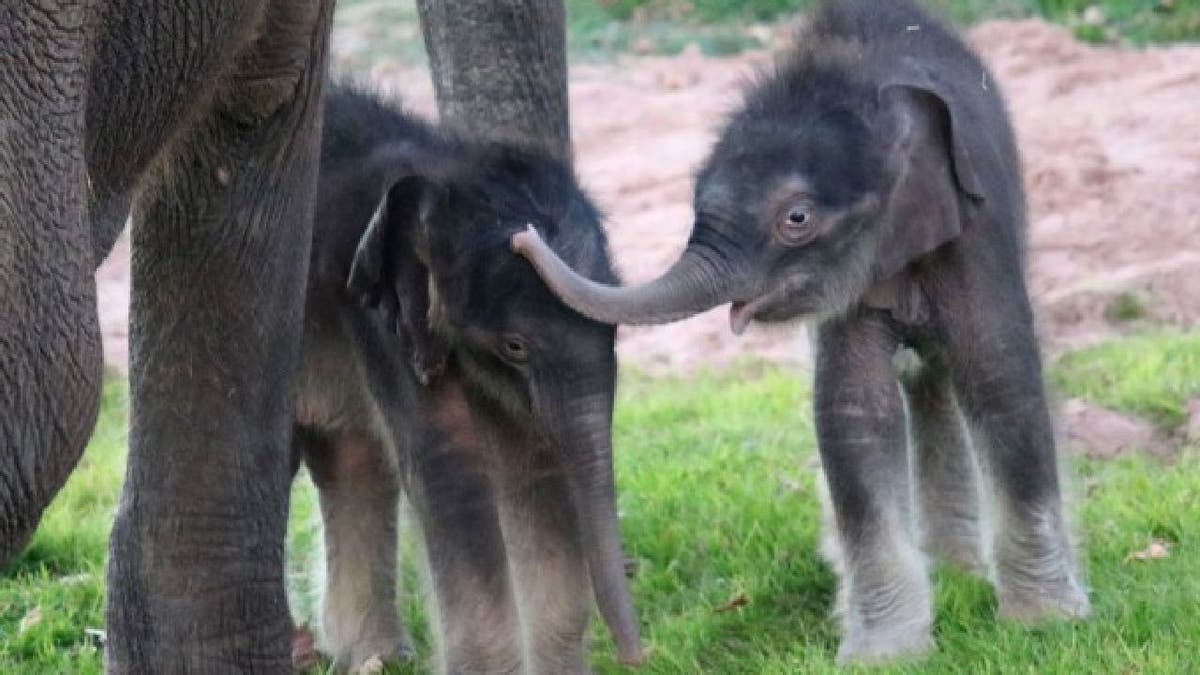Fox News Flash top headlines for November 11
Fox News Flash top headlines are here. Check out what's clicking on Foxnews.com.
A zoo in New York is now home to a pair of rare elephant twins and visitors can finally see the newborn calves in person.
Asian elephants Mali and Doc welcomed two male calves on Oct. 24 at the Rosamond Gifford Zoo in Syracuse, New York, according to a zoo press release issued on Thursday, Nov. 10.
Elephant twins make up less than 1% of elephant births worldwide, according to the Rosamond Gifford Zoo.
Many instances of elephant twin pregnancies reportedly result in calf or maternal deaths.
ELEPHANTS IN THAILAND GET FRUIT-AND-VEGGIE BUFFET IN CELEBRATION OF 'NATIONAL ELEPHANT DAY'
"To date, there has never been a recorded case of surviving elephant twins in the United States," the Rosamond Gifford Zoo wrote.
"The few successful twin births have only taken place in their range countries in Asia and Africa and nowhere else in the world."

Mali, an Asian elephant at the Rosamond Gifford Zoo in Syracuse, New York, gave birth to twins — which is a rarity in the species. (Rosamond Gifford Zoo )
Staff at the Rosamond Gifford Zoo hadn’t anticipated the birth of twins due to the "sheer improbability" and the "complexity" that comes with elephant ultrasounds, the press release goes on.
Mali and her two calves are in good health and all three have been receiving around-the-clock monitoring from the zoo’s elephant care team, according to the Rosamond Gifford Zoo.
The elephant care team and veterinary staff reportedly nursed the second calf to health with a specialized milk replacer.
The first calf was born at 2 a.m. with no complication and weighed 220 pounds while the second calf was born at 11:50 a.m. and weighed 237 pounds, but he was "noticeably weaker than the first," the zoo reported.
The elephant care team and veterinary staff reportedly nursed the second calf to health with a specialized milk replacer.
ELEPHANTS AT MILWAUKEE ZOO HAVE SMASHING 'GOURD' TIME WITH GIANT PUMPKINS
Visitors can see the elephant twins at the zoo’s indoor Pachyderm Pavilion or the outdoor Helga Beck Asian Elephant Preserve, weather permitting, from 11-11:30 a.m. or 2-2:30 p.m.
"This is truly a historic moment for the zoo and our community," said Ryan J. McMahon, county executive at the Rosamond Gifford Zoo, in a statement.
"I couldn’t be prouder of our exceptional animal care team, the support of the veterinary staff and their tremendous dedication to Mali and the twins," Mahon continued.
"The important research happening right here at the zoo will have a significant impact worldwide on behalf of this magnificent endangered species."
'WORLD’S LONELIEST ELEPHANT' CLEARED FOR RELOCATION TO A BETTER FACILITY OUTSIDE OF PAKISTAN
The birth of the elephant twins has provided a chance for researchers to study the calves’ placentas for vaccine development and possible treatments for Elephant Endotheliotropic Herpes Virus (EEHV), a lethal strain of herpes that can kill young elephants.
Mali’s two calves, Batu and Ajay, died from the disease in December 2020, according to the Rosamond Gifford Zoo.
CLICK HERE TO GET THE FOX NEWS APP
The zoo’s eight-member elephant herd is reportedly tested for EEHV twice a week by the Rosamond Gifford Zoo Animal Health Center.
Asian elephants are classified as endangered by the World Wildlife Fund (WWF) and the International Union for the Conservation of Nature (IUCN), two global organizations focused on wildlife conservation.

Both of the male calves that Mali gave birth to on Oct. 24, 2022, weighed more than 200 pounds. (Rosamond Gifford Zoo )
The WWF estimates there are fewer than 50,000 Asian elephants in the wild, while the IUCN estimates there are about 48,000 to 50,000.
Habitat loss, human conflicts and ivory poaching have reportedly contributed to the dwindling Asian elephant population in 13 forested ranges throughout South Asia and Southeast Asia, including India, Malaysia, Thailand, Myanmar and Sri Lanka.
CLICK HERE TO SIGN UP FOR OUR LIFESTYLE NEWSLETTER
Asian elephants can reportedly grow up to 11.5 feet in height, measure about 21 feet in length and weigh up to 11,000 pounds, according to the World Wildlife Fund.

